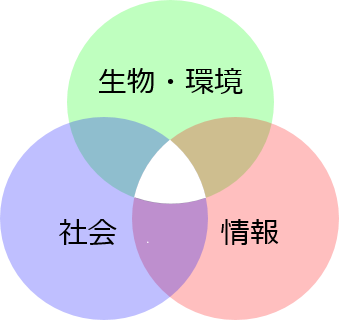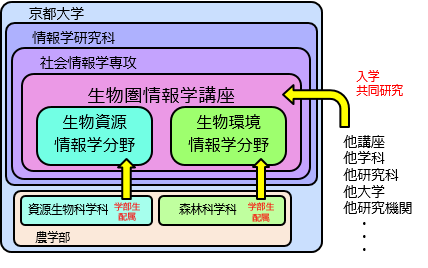We provide for research in the field of biology, environmental science, information science, and sociology. There is a wide variety of organisms in the biosphere ranging from forest to agricultural land to ocean. They correlate complexly and have multiple and mutual effects on human society. We consider these biospheres as a global complex system, and we try to comprehend the information on biological environments, material cycles in ecosystems, biological resource production by large-scale networks. We also study mutual effects of the human society and the global environment.
We Biosphere Informatics Lab consist of biological resources informatics course and bioenvironmental informatics course.


Bioresource Informatics
– Aim to perform studies based on biological resources information –
We approach various research themes, especially for the use of biological information to determine the sustainable yields of biological resources and on the conservation of endangered species. More specifically, 1) the development of positioning-system techniques (e.g. GPS, biologging, and biotelemetry), environmental DNA methods for the acquisition of information on biological resources, the development of data-analysis techniques (e.g. multivariate and acoustic analyses) for biological resources information. 2) We approach various propositions related to bioresource science, biology, and ecology using big data such as geographic information, satellite information, and databases.
Environmental Informatics
– Aim for the establishment of information systems facilitating a symbiotic relationship between the human society and its biological environment –
Components of the biosphere interact, and influence the human society in various ways. We mainly focus on terrestrial ecosystems, investigate the life and its environment, and discuss their relation with human society. Our research covers diverse organisms such as animals (including humans), plants, and microbes in various environments ranging from natural ecosystems to human societies. We apply various methods and techniques to collect data such as field observations, chemical/isotopic/genetic analysis, questionnaires and interviews. We try to understand the life and its environment, based on the spatial-temporal analysis and modelling of data collected in the field.
For more information on our research, see seminars.
Click here to see our members.